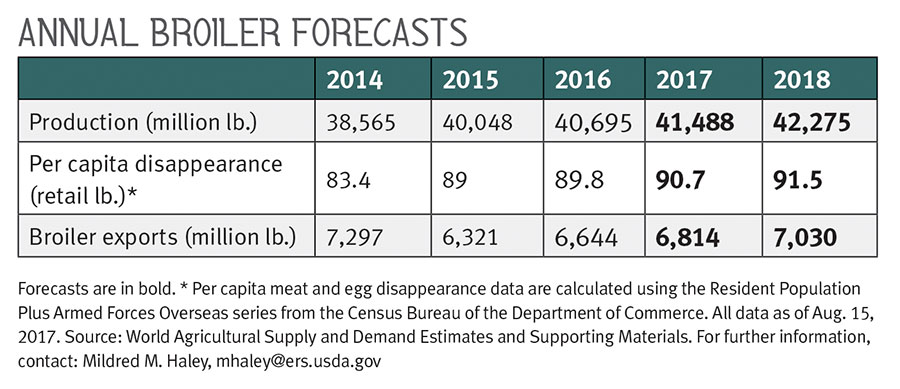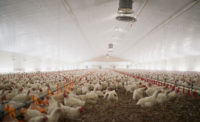Barring a disruptive event, 2018 should be another Goldilocks year for chicken producers/processors. “Not too hot, not too cold” characterizes chicken market conditions for 2017 with indicators pointing to a repeat situation in the New Year. With 2018’s production increase most likely matching the pace in 2017 and 2016, one of the basic fundamentals determining the outlook appears to be somewhat given. The U.S. Department of Agriculture’s (USDA) forecast for broiler production in 2018 is for a nearly 2 percent or so gain over 2017, compared with an almost similar increase in 2016.
One ongoing challenge, however, is the slippage between weekly eggs being set for hatching and the resulting day-old chicks available to be placed on growout farms. In 2017, 3 percent more eggs were being were set in incubators, but only 2 percent more baby chicks were placed on farms. Analysts noted a number of factors for the slippage between eggs sets and chicks placed. Among the reasons suggested are the changed genetics of the breeder hens, the age of the hatchery supply flock, and the measurable shift away from using antibiotics in breeder flocks and in the hatchery. As the industry moves through 2018, the year-over-year comparisons should begin to move back toward a more normal scenario between weekly egg sets and weekly chicks placed.
With feed costs being the major cost factor, there are legitimate concerns that the up-tick in corn and soybean prices will carry over well into 2018. But even if the U.S. grain and oilseed crops are not at record high levels, there are more reasons than fewer to expect continued favorable feed costs. In fact, a slightly improving feed-cost path going forward is quite possible. Carry-over grain and oilseed stocks are most adequate, and South American crops are abundant. The trade-weighted value of the U.S. dollar continues to be strong, thus causing pressure for more of the U.S. feedstuffs to stay home rather than be exported to global markets.
Robust demand continues
Turning to the other side of the supply/demand equation, it is not overly optimistic to believe the U.S. economy will continue to maintain or even improve its growth in consumer income and that fewer unemployed and under-employed workers will be the situation. More than a few studies have documented the tight linkage between a strong economy, favorable chicken prices and an excellent demand for chicken. Despite more of all competing meats in 2017 and 2018, chicken is demanded briskly at retail grocery and foodservice.
Export demand for chicken, while improving, could be better. Export managers keep hoping to get back to the record level of chicken exports experienced in 2013 and build from there. USDA does not forecast record chicken exports in 2018 but the direction is positive.

More efficient line speeds?
In-plant processing costs, second only to feed costs for producing/processing a pound of chicken, may begin to see an opportunity in 2018 to become more manageable. If USDA approves more efficient inspection line speeds for chicken, processing plants will begin to implement plans to benefit from the change. Many poultry plants have operated on a pilot basis for several years at the more efficient line speeds and have consistently demonstrated the same or better levels of food safety, worker safety, product quality and similar measurements. USDA requires higher standards when plants operate at the more efficient line speeds.
However, it is not as simple as turning up the speed for the number of carcasses moving on the lines. It will take time for chicken complexes to add equipment that has greater capacity, contract for additional growout housing, and all the steps needed at both the live-bird level and the processing level to fully operate a complex using the more efficient line speeds. That process can begin in 2018 following USDA approval, but the rollout industrywide will take years to achieve.
Summary
Challenges, opportunities, and the unexpected surprises that seem so evident in hindsight will certainly continue to be in the mix for 2018. But the chicken industry’s recipe for the New Year will likely result in a tasty bowl of porridge that is not too hot and not too cold. NP




Report Abusive Comment